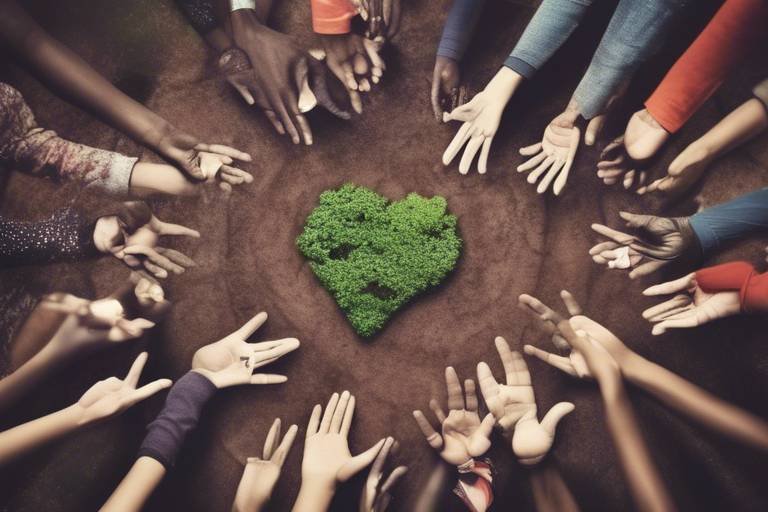How to Organize a Community Clean-Up Day
Organizing a community clean-up day can be a truly impactful and rewarding experience that not only benefits the environment but also fosters a sense of unity and camaraderie among participants. It's a chance to come together as a community and make a tangible difference in the world around us. Planning and executing a successful clean-up event requires careful consideration and coordination at every step of the way.
First and foremost, selecting the right date and location is crucial to ensure maximum participation and effectiveness. Choose a date that accommodates the schedules of the majority of potential volunteers and select a location that is in dire need of cleaning. Securing any required permits or permissions from local authorities is essential to avoid any legal complications.
Recruiting volunteers is the lifeblood of any community clean-up day. Reach out to various local groups, schools, businesses, and utilize online platforms to spread the word and gather a diverse group of participants. Creating a sign-up sheet and leveraging social media and traditional flyers can help attract a wide range of volunteers.
Gathering the necessary supplies is another key aspect of organizing a successful clean-up day. Ensure you have enough trash bags, gloves, litter pickers, and other cleaning materials for all volunteers. Consider seeking donations or sponsorship from local businesses to cover the costs of these supplies and make the event more sustainable.
Prioritizing safety should be at the forefront of your planning process. Develop a comprehensive safety plan that includes guidelines on handling waste, wearing protective gear, and staying hydrated. Having a designated safety coordinator and a well-equipped first aid kit on-site is essential to address any unforeseen incidents.
Proper waste disposal is crucial to ensure the environmental impact of the clean-up day is minimized. Coordinate with local waste management services or recycling facilities to arrange for the appropriate disposal of collected waste. Encourage volunteers to separate recyclables from trash to promote sustainability.
Keeping volunteers motivated and engaged throughout the clean-up day is key to its success. Provide refreshments such as water and snacks to keep energy levels up, and consider offering small incentives like certificates or t-shirts as tokens of appreciation. Recognizing and thanking participants for their hard work can go a long way in boosting morale.
On the day of the event, execute your plan with precision and enthusiasm. Set up registration tables, distribute supplies efficiently, and assign cleaning areas to volunteers based on their preferences and capabilities. Clear communication and coordination are essential to ensure a smooth and productive clean-up day.
Documenting the success of the event is important for showcasing the impact of community efforts. Capture the day through photos and videos to share on social media and with local news outlets. Consider hosting a closing ceremony to celebrate achievements, recognize outstanding contributions, and express gratitude to all those involved in making the clean-up day a success.
Organizing a community clean-up day is not just about picking up trash; it's about coming together as a community to create positive change and leave a lasting impact on the environment and the people involved. By following these steps and infusing your event with passion and dedication, you can organize a memorable and effective clean-up day that brings people together for a common cause.

Selecting a Date and Location
Organizing a community clean-up day can be a rewarding experience that brings people together to improve the environment. This article provides a step-by-step guide on how to plan and execute a successful clean-up event.
When it comes to selecting a date and location for your community clean-up day, there are several factors to consider. Choose a date that works for the majority of participants, taking into account school holidays, work schedules, and local events that may conflict. Additionally, select a location that is in need of cleaning and where the impact of the event will be most significant. Obtain any necessary permits or permissions from local authorities to ensure a smooth operation.

Recruiting Volunteers
Recruiting volunteers for a community clean-up day is crucial to the success of the event. To gather a dedicated team of individuals willing to contribute their time and effort, various strategies can be employed. One effective approach is to reach out to local community groups, schools, and businesses that have a vested interest in environmental conservation. Engaging with these organizations can help spread the word about the clean-up day and attract participants who are passionate about making a positive impact.
Creating a sign-up sheet can streamline the volunteer recruitment process by allowing interested individuals to register their participation. This not only helps organizers keep track of the number of volunteers but also enables them to communicate important event details and instructions effectively. Additionally, promoting the clean-up day through social media platforms and distributing flyers in high-traffic areas can help reach a broader audience and encourage community members to get involved.
When recruiting volunteers, it is essential to highlight the benefits of participating in the clean-up event. Emphasizing the opportunity to contribute to a cleaner environment, foster community spirit, and make a tangible difference can motivate individuals to volunteer their time. Offering incentives such as volunteer certificates, t-shirts, or recognition awards can also incentivize participation and show appreciation for the volunteers' hard work.

Gathering Supplies
When it comes to organizing a successful community clean-up day, is a crucial step in ensuring the event runs smoothly and efficiently. It's essential to have all the necessary tools and equipment to tackle the cleaning tasks effectively.
One of the primary supplies needed for a clean-up day is trash bags. Make sure to have an an ample supply of durable, large trash bags to collect the litter and waste efficiently. Having extra bags on hand is always a good idea to handle any unexpected increase in trash volume.
Gloves are another essential item to protect volunteers' hands from sharp objects, chemicals, or other hazardous materials they may encounter during the clean-up. Providing different sizes of gloves ensures a comfortable fit for everyone participating.
Litter pickers are valuable tools that make it easier to pick up trash in hard-to-reach areas or areas with potential safety hazards. These tools can help volunteers reach items without risking injury or exposure to harmful substances.
Consider reaching out to local businesses for donations or sponsorship to cover the costs of supplies. Many businesses are willing to support community initiatives, and this can help offset the expenses associated with organizing a clean-up event.
Having a supply station set up at the event location is essential for easy access to supplies throughout the day. Organize the supplies neatly and efficiently so that volunteers can quickly grab what they need without any confusion or delays.
Remember, the success of a community clean-up day often depends on the availability and quality of the supplies provided. By ensuring you have all the necessary tools and equipment gathered beforehand, you set the stage for a productive and impactful event that benefits both the community and the environment.

Creating a Safety Plan
Organizing a community clean-up day can be a rewarding experience that brings people together to improve the environment. This article provides a step-by-step guide on how to plan and execute a successful clean-up event.
Choose a date that works for the majority of participants and select a location in need of cleaning. Obtain any necessary permits or permissions from local authorities.
Reach out to local community groups, schools, businesses, and online platforms to recruit volunteers. Create a sign-up sheet and promote the event through social media and flyers.
Collect trash bags, gloves, litter pickers, and other cleaning supplies. Consider reaching out to local businesses for donations or sponsorship to cover the costs.
Prioritize safety by providing volunteers with guidelines on handling waste, wearing protective gear, and staying hydrated. Have a first aid kit on-site and designate a safety coordinator.
Arrange for proper disposal of collected waste by coordinating with local waste management services or recycling facilities. Sort recyclables from trash to minimize environmental impact.
Keep volunteers motivated by providing water, snacks, and small incentives like certificates or t-shirts. Recognize and thank participants for their hard work and dedication.
On the day of the event, set up registration tables, distribute supplies, and assign cleaning areas to volunteers. Ensure clear communication and coordination throughout the day.
Capture the event through photos and videos to share on social media and local news outlets. Host a closing ceremony to celebrate achievements and express gratitude to all involved.
If you have any questions about organizing a community clean-up day, check out the following FAQs:
Q: Do I need any special skills to organize a clean-up event?
A: No special skills are required, just a passion for the environment and a willingness to bring the community together for a good cause.
Q: How can I get local businesses involved in sponsoring the event?
A: Reach out to businesses in your area with a proposal outlining the benefits of sponsorship, such as positive PR and community engagement.
Q: What should I do in case of an emergency during the clean-up day?
A: Make sure to have a designated safety coordinator who is trained in first aid and emergency procedures. Have emergency contact numbers on hand and a clear evacuation plan.

Implementing Waste Disposal
Implementing waste disposal is a crucial aspect of organizing a successful community clean-up day. Proper disposal of the collected waste is essential to minimize environmental impact and ensure the cleanliness of the area. Coordination with local waste management services or recycling facilities is key to effectively managing the disposal process.
One strategy to streamline waste disposal is to sort recyclables from trash during the clean-up. Providing separate bins or bags for recyclable materials allows volunteers to easily distinguish between items that can be recycled and those that need to be disposed of as trash. This not only promotes environmental sustainability but also facilitates the recycling process post-clean-up.
Another important consideration is to ensure that hazardous waste, such as chemicals or sharp objects, is handled and disposed of safely. Designating specific volunteers or professionals with the expertise to manage hazardous materials can prevent accidents and environmental contamination.
Communication with volunteers regarding proper waste disposal procedures is essential. Providing clear instructions on how to handle different types of waste, emphasizing the importance of recycling, and highlighting any specific disposal guidelines for the area can help maintain a clean and organized clean-up process.
Additionally, having designated waste collection points throughout the clean-up site can aid in efficient waste disposal. Volunteers can easily deposit their collected trash and recyclables at these designated areas, allowing for centralized collection and subsequent disposal.
Lastly, post-clean-up waste audits can provide valuable insights into the types and quantities of waste collected. Analyzing this data can inform future clean-up efforts, identify recurring sources of litter, and guide community initiatives to reduce waste generation and promote sustainable practices.

Organizing Refreshments and Rewards
When organizing a community clean-up day, it's essential to consider the well-being and motivation of the volunteers. Providing refreshments and rewards can go a long way in keeping participants energized and engaged throughout the event. Imagine the satisfaction of enjoying a cool drink or a snack after a hard day's work of cleaning up the neighborhood. It not only replenishes their energy but also shows appreciation for their dedication.
Setting up a refreshment station where volunteers can grab a bottle of water, a piece of fruit, or a granola bar can make a significant difference. Consider having a variety of options to cater to different preferences and dietary needs. A well-hydrated and nourished volunteer is likely to be more productive and feel valued.
In addition to refreshments, offering rewards can further incentivize volunteers to participate and contribute their best efforts. Simple gestures like providing certificates of appreciation, customized t-shirts, or small tokens of gratitude can leave a lasting impression. It's like a pat on the back for a job well done, encouraging volunteers to continue their involvement in community initiatives.
Creating a sense of camaraderie through shared refreshment breaks and rewarding moments can strengthen the bond among volunteers. It fosters a positive atmosphere and a feeling of belonging, turning a clean-up day into a memorable and enjoyable experience for everyone involved.

Executing the Clean-Up Day
Executing the Clean-Up Day involves putting all the planning into action to ensure a successful event. On the day of the clean-up, it's crucial to have a well-organized setup to streamline operations and maximize efficiency. Setting up registration tables at the entrance will help in checking in volunteers and assigning them to specific cleaning areas.
Dividing the cleaning areas ensures that every part of the location receives attention and no area is left unattended. Assigning team leaders to oversee each section can help in managing the volunteers effectively. Clear communication is key during the event to provide instructions, updates, and ensure everyone is on the same page.
Having a designated area for supplies distribution is essential to equip volunteers with the necessary tools for the clean-up. This includes trash bags, gloves, litter pickers, and any other required items. Volunteers should be briefed on safety guidelines before starting the clean-up activities to prevent accidents and ensure a smooth operation.
Throughout the day, it's important to monitor progress and address any issues that may arise promptly. Having a central point of contact for volunteers to report problems or ask questions can help in maintaining a well-coordinated event. Regular check-ins with team leaders can provide updates on the progress of each cleaning area.
As the clean-up activities come to an end, it's essential to gather all volunteers for a closing ceremony. This is a time to celebrate the collective effort, acknowledge everyone's hard work, and express gratitude for their participation. Providing refreshments and small rewards can further motivate volunteers and leave a positive impression on everyone involved.

Documenting and Celebrating Success
Documenting and Celebrating Success is a crucial step in recognizing the efforts and achievements of the community clean-up event. By capturing the event through photos and videos, you can showcase the impact of the day and inspire others to get involved. Sharing these visuals on social media platforms and local news outlets can amplify the reach of the event, highlighting the positive contributions of the volunteers.
Hosting a closing ceremony to celebrate the success of the clean-up day is a great way to bring everyone together one last time. This ceremony can include speeches thanking the volunteers, acknowledging sponsors and partners, and highlighting the amount of waste collected and areas cleaned. It's an opportunity to express gratitude to all those who participated and contributed to making the event a success.
Consider creating a scrapbook or digital album with the photos and videos from the event. This can serve as a lasting memory of the community coming together for a common cause. Additionally, sending personalized thank-you notes or emails to volunteers, sponsors, and local authorities can further demonstrate appreciation for their support and commitment to the clean-up initiative.
Frequently Asked Questions
- How can I get involved in a community clean-up day?
To get involved in a community clean-up day, you can start by checking local community centers, schools, or environmental organizations for upcoming events. You can also reach out to the event organizers directly to inquire about volunteer opportunities and how you can contribute to the clean-up efforts.
- What should I bring to a clean-up event?
It is recommended to bring your own gloves, comfortable clothing, closed-toe shoes, and sunscreen to a clean-up event. Additionally, consider bringing a reusable water bottle to stay hydrated throughout the day. The event organizers will usually provide the necessary cleaning supplies like trash bags and litter pickers.
- Can children participate in community clean-up days?
Yes, children can participate in community clean-up days under adult supervision. It is a great opportunity for families to engage in environmental activities together and instill a sense of responsibility towards the community and nature in children. Make sure to check with the event organizers for any age restrictions or specific guidelines for children participants.



















